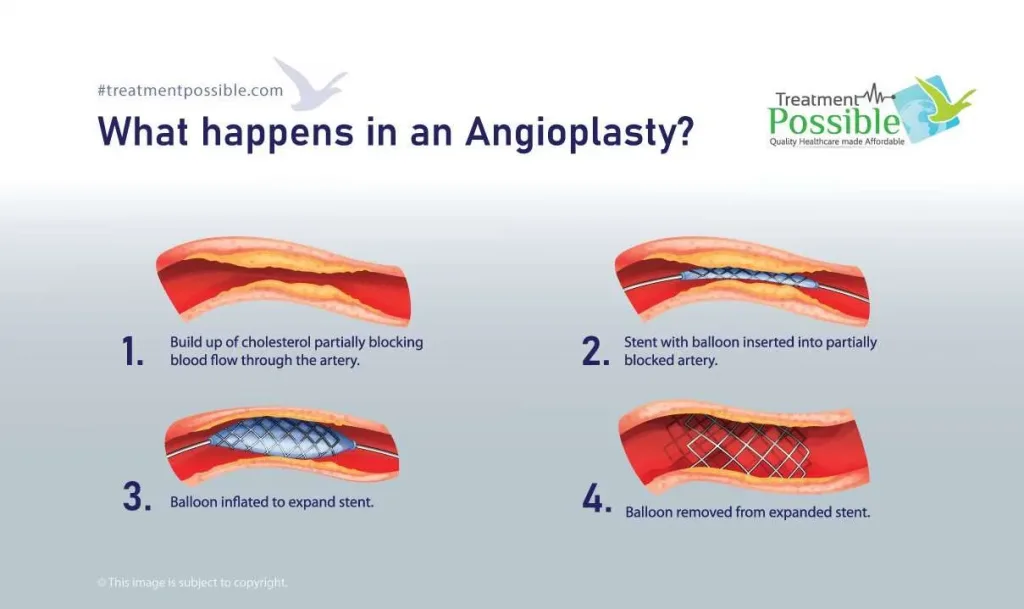Angioplasty
Why do you need Angioplasty?
Coronary angioplasty is used to open a blocked or narrowed artery around the heart and restore proper blood flow. Angioplasty is also known as percutaneous coronary intervention. Angioplasty is used to treat the build-up of fatty plaques in your heart’s blood vessels known as atherosclerosis (hardening of the arteries).
Angioplasty is also recommended in the following cases:
- Angioplasty improves the symptoms of blocked arteries, such as chest pain and shortness of breath due to CAD.
- If you are not feeling better despite medicines and lifestyle changes to reverse atherosclerosis.
- If you have a coronary bypass graft that has closed or narrowed.
- Angioplasty is used to treat an abnormal stress test.
- Angioplasty is used to improve blood supply to the heart muscle which will help to prevent a heart attack.
- Angioplasty is also used during a heart attack to quickly open a blocked artery and reduce the amount of damage to your heart.
- Angioplasty is used to improve blood supply to the heart muscle after a heart attack.
Once your artery is blocked or narrowed then Coronary angioplasty is recommended. But before the surgery, you will need to select the type of angioplasty.
What are the Types of Angioplasty?
Coronary angioplasty is a minimally invasive procedure which restores normal blood flow to a blocked or narrowed artery supplying blood to your heart. There are two types of angioplasty:
- Balloon angioplasty uses a tiny balloon catheter which is inserted in a blocked blood vessel to improve blood flow to your heart. Balloon angioplasty involves using the pressure of an inflated balloon to clear plaque that is blocking an artery.
- Stent placement in the artery – Angioplasty is often combined with the placement of a small wire mesh tube called a stent. The stent helps to open the artery, decreasing its chance of narrowing again. Stents will help to prevent artery narrowing again after angioplasty.
After selecting the type of angioplasty, you are prepared for the Coronary angioplasty surgery.
How is an Angioplasty Performed?
Angioplasty is performed by a heart specialist (cardiologist), depending on the number of blockages.
- Step 1 – Before beginning angioplasty, a surgeon will clean and numb the area where the catheter enters the body, usually the groin but sometimes the wrist.
- Step 2 – Next, a doctor inserts the catheter into the artery and directs it towards the coronary artery, watching its progress through an X-ray.
- Step 3 – Once the catheter is in position, the doctor injects a contrast dye through the artery, which helps identify blockages around the heart.
- Step 4 – Once the blockages are located, the doctor inserts a second catheter and a guidewire, usually with a balloon at the tip.
- Step 5 – When the second catheter is in position, the doctor inflates the balloon, which pushes the plaque build-up away and opens up the artery. The surgeon may insert a stent to keep the artery open.
Want more clarification about medical expense & treatment plan?
Consult an Experienced Doctor online for a free diagnosis

What happens after Angioplasty?
After angioplasty, your doctor will remove the catheters and bandages. Soreness, bruising, and possibly bleeding is common around the area where catheters had entered the body.
- If your catheter was put into the artery at your wrist or arm, your doctor will put a special bandage to make sure it heals properly. You will wear this for a couple of hours. The doctor or a nurse will remove it and check if your artery has healed. You should not eat or drink anything except clear liquids until the groin sheath is removed because you can get nauseated while it is on. Once you start eating, you will be urged to follow a heart-healthy diet.
- If the catheter was put into the artery at your groin, you will have to lie flat (without bending your legs) while the groin sheath is in place. A sheet will be placed across your leg with the sheath to remind you to keep it straight. After the sheath is removed, you have to lie flat for about 6 hours to prevent bleeding.
- If you had a nonemergency procedure, you have to stay at the hospital overnight while your heart is monitored and your medications are adjusted. You should be able to return to work or your normal routine one week after the angioplasty.
The follow-up visit after angioplasty is a very important part of the treatment. The doctor will review the individual’s recovery, adjust medications as needed, and develop an ongoing treatment plan for cardiovascular health. After you return home, drink plenty of fluids to help flush your body of the contrast dye. Avoid strenuous exercise and do not lift heavy objects for at least a day.
What are the Do’s & Don’ts after Angioplasty?
After having an angioplasty and stenting, you should continue healthy lifestyle habits and take medications as prescribed by your doctor. You should keep the following in mind to keep your heart healthy after angioplasty:
- You should quit smoking
- You should lower your cholesterol levels
- You should eat a healthy diet that is low in saturated fat
- You should maintain a healthy weight
- You should control other conditions, such as diabetes and high blood pressure
- You should get regular exercise
- You should intake medication prescribed by your doctor.
- You should drink 8 to 10 glasses of clear fluids (water is preferred).
- You should keep the surgical area clean and dry while taking a shower.
- You should not use creams, lotions or ointment on the wound site.
- You should wear loose clothes.
- You should not strain during bowel movements for 3 to 4 days to prevent bleeding from the catheter insertion site.
A successful angioplasty means that you might not have to undergo coronary artery bypass surgery, a more invasive procedure that requires a longer recovery time.
Angioplasty at Treatment Possible:
Treatment Possible ensures high-quality angioplasty surgery is provided while we guarantee the lowest median cost. Our understanding of the Indian Healthcare market and our valued relationship with Heart Specialists enables us to ensure reasonable, affordable and flexible angioplasty surgery cost in India.
The angioplasty cost is very high in advanced countries, especially the stent cost. A USA Food and Drug Administration (FDA) approved coronary stent along with the angioplasty cost in India would be USD 3500 to 5000 depending on the patient’s cardiac condition and vital signs. The angioplasty price in India may vary slightly according to Hospital Standards and different coronary stent choices.
Treatment Possible through its expert International patients’ treatment services team and medical tourism professionals has flexible payment options besides offering the best hospital for angioplasty in India with customized treatment plans.
International patients get a free consultation with chosen Top cardiac specialists in India. Call +91 9820327706 and get a free consulting session with top coronary angioplasty surgeons in India.
If you require angioplasty surgery cost in India, then please contact care@treatmentpossible.com for free opinion and comprehensive treatment plans. Get a free consultation with chosen top heart surgeons in India with the hassle-free facility of post-operative recovery care, diagnostic modalities, travel & medical stay.
